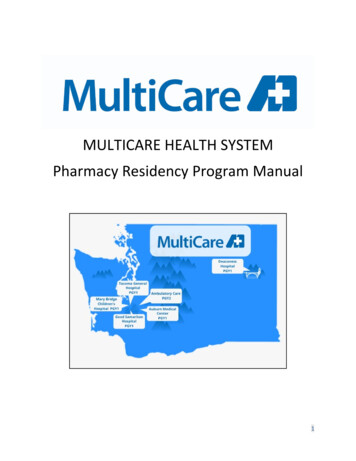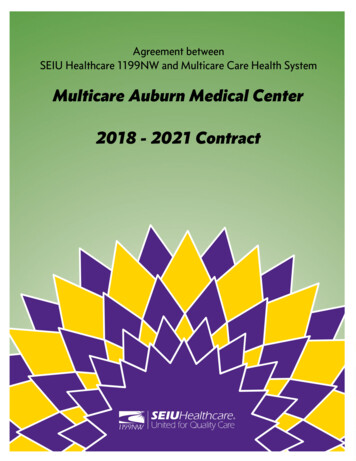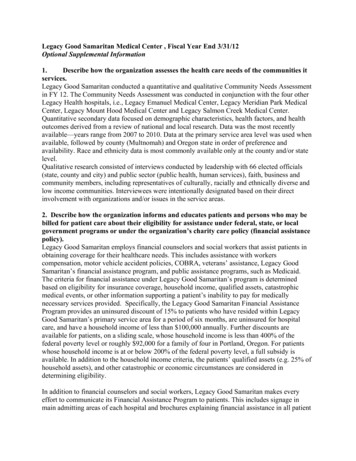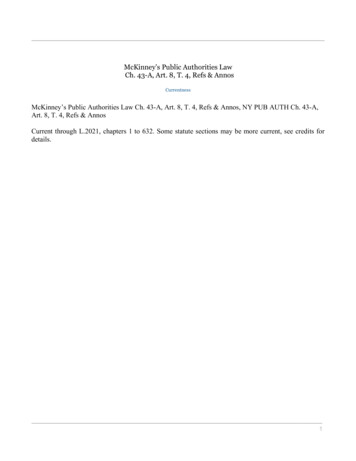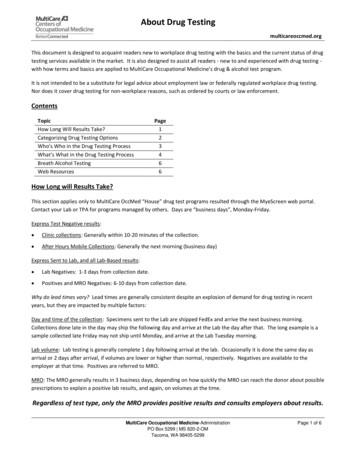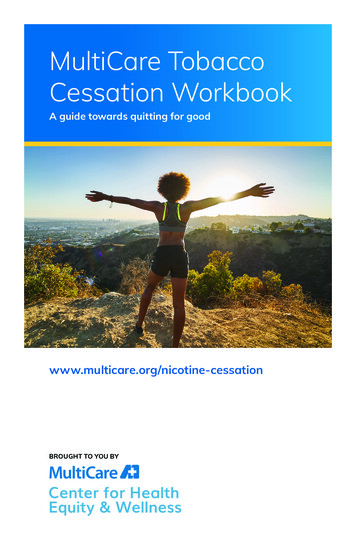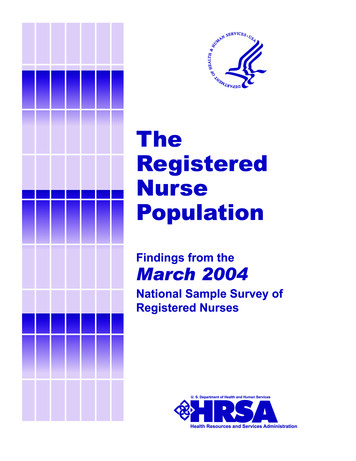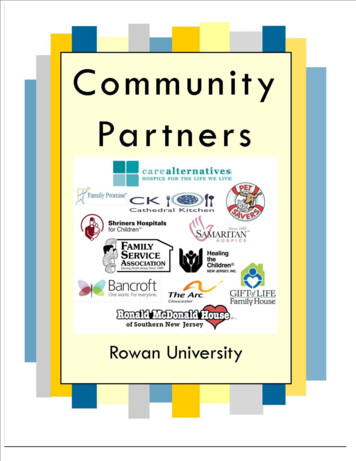
Transcription
NURSE STAFFING PLAN PURPOSEThis plan was developed for the management of scheduling and provision of daily staffing needs for thehospital, and to define a process that ensures the availability of qualified nursing staff to provide safe, reliableand effective care to our patients. This plan applies to all parts of the hospital licensed under RCW 70.41.STAFFING PLAN PRINCIPLESThe following principles guide staffing at MultiCare Good Samaritan Hospital:At all times, each patient admitted to the hospital is assigned a registered nurse (RN) who isaccountable for the patient's care. This responsibility includes making assessments, creating andcarrying out a plan of care, teaching, seeking consultations, communicating problems to themedical team, and evaluating the effectiveness of care. The optimal staffing plans represent a partnership between nursing leadership and direct care staff. All staffing plans are designed to minimize the risk of unplanned overtime (OT). Staffing plans include allocation for direct patient care. These principles correspond to The American Nursing Association Principles of Safe Staffing and areimplemented as follows:Unit-RelatedAppropriate staffing levels for a patient care unit reflect analysis of individual and aggregate patientneeds.The budget allocation of direct nursing resources at Good Samaritan Hospital is determined annually.Multiple factors are analyzed and considered: benchmark data census acuity staff qualifications turnover patient safety outcomes new technology throughput outcomes trends for seasonality and time of day when patients present for service anticipated needs of new or changing patients meal and rest breaks for staffEach department/unit confirms their numbers of nurses to schedule for each 6-week schedule in theupcoming 6 months. These targets are based on the factors stated above, as well as historical sick use, andmore current patient care and safety considerations of resources anticipated.
Schedule targets are also adjusted based on seasonal patterns and trends in acuity and patient volume. GoodSamaritan can see considerable variation in census across winter viral season and summer surgical season.To cover staffing shortfalls during unpredictable times of high census, we utilize our float pools, implementvoluntary on call systems and may hire traveling RNs for temporary assignments. The goal is to care for thepatients and families who present themselves to us.Staff meal and rest breaks are in accordance with WSNA and Good Samaritan bargaining agreement andWashington State laws. Charge RNs partner with clinical staff to identify and schedule appropriate times forstaff to take their meal and rest breaks. Staff use their identified chain of command to escalate real-timebarriers so that appropriate coverage can be obtained for the break/meal period.Unit functions necessary to support delivery of quality patient care must also be considered in determiningstaffing levels.Good Samaritan maintains a hospital wide Nurse Staffing Committee that develops the nurse staffing planand partners with nursing and hospital leadership in assuring safe staffing for all patients. Units shall beinvited to present to the house-wide staffing committee twice each year.
UNIT DESCRIPTORS AND SUMMARY OF STAFFINGInpatient Nursing UnitsInpatient Nursing Units consist of the following units: Medical PalliativeMedical OncologyPost-SurgicalObservation UnitCardiac CareProgressive CareIntensive CareInpatient Trauma and Neuro Rehabilitation UnitEach department has included a more detailed description of the type of care provided in their area below.All nursing care includes assessment, problem identification, planning, implementation, and evaluation of thedelivery of care and the patient’s response to medical and nursing therapy.The staffing grid is the goal for staff scheduling per day and shift based on average daily census and budgetedhours of care. Direct hours per unit of service reported below include RN, PTCA, HUC, and Sitter directproductive hours divided by budgeted daily census. Average daily census in the tables under each unit is the2022 budgeted average daily census for the unit.For daily staffing needs, the Charge RN determines the number of staff needed based on a calculation of theunit census and budgeted hours of nursing care. The Charge RN then reviews any additional factors such asacuity, admissions, discharges, and transfers, geography, and skill mix needs in order to determine the totalnumber of staff needed to safely care for the patients. Units also have a huddle structure that can be used toinform the CN and potentially make necessary adjustments to patient assignments. Staffing needs arereviewed in four-hour blocks and adjustments made for areas that are open 24 hours a day. The majority ofinpatient staff work 12-hour shifts, but staff can be scheduled into 4, 8, or 12-hour shifts depending on theirFTE and other indirect time. Shifts start at 7am, 11am, 3pm, 7pm, or 11pm unless otherwise indicated.Good Samaritan has a centralized staffing office that coordinates the staffing needs of the inpatient areas andassure the staffing needed to support their staffing plans. Inpatient nursing units also use staff within a floatpool that are deployed through a centralized staffing office to the areas that identify staffing needs. Unitbased staff may also float to another department who has a staffing need in accordance with union contractPatient placement within the hospital is coordinated through the Hospital Supervisor and is in accordancewith admission, discharge, and transfer criteria. Staff use the following chain of command for staffingconcerns or issues, Charge Nurse, Unit Nurse Manager or Assistant Nurse Manager, House Supervisor, UnitDirector, Chief Nurse Executive.
Medical PalliativeThis unit supports 47 adult care beds, 32 beds on the 4 River floor, and 15 beds on the 3 River floor. Thisdepartment specializes in palliative care-end of life care- CMO (Comfort Measures Only), medicalmanagement of complex and high acuity medical patients, long-term and total care patients, difficult toplace patients, and general medical patients.In general, RNs on the unit are assigned four to five patients. The assigned charge nurseshares responsibility for 4 River and 3 River units and responds to needs in both locations.PTCA will be staffed as patient observers (sitters) as needed and are either staffed by the unitor from the central float pool.Medical PalliativeNumber of beds47Average daily census43Direct hours per patient day10.47Average patients/RNDirectCaregiverCharge 9Night9999999Day5555555Night5555555PTCA (Sitter) Day1.751.751.751.751.751.751.75PTCA (Sitter) Night1.751.751.751.751.751.751.751111111DayHUC Day
Medical Oncology42 bed adult care located on the 6th floor of the Dally Tower, 2 negative pressure rooms, 10 ceiling liftrooms, 25 rooms with dialysis capability. All rooms have the capability for remote telemetry monitoring.This unit in inpatient oncology patients, medical management of complex and high acuity medical patients,long-term and total care patients, difficult to place patients, and general medical patients.In general, RNs on the unit are assigned four to five patients. PTCA will be staffed as patientobservers (sitters) as needed and are either staffed by the unit or from the central float pool.Medical OncologyNumber of beds42Average daily census39Direct hours per patient day10.00Average patients/RNDirectCaregiverCharge 252.252.251111111PTCA (Sitter) DayOther4-5PTCA (Sitter) NightHUC Day2.25
Post-SurgicalThis is a 40-bed adult care located on the 7th floor of the Dally Tower, 3 negative pressure rooms, 4 ceiling liftrooms, 10 rooms with dialysis capability. All rooms have the capability for remote telemetry monitoring.This unit specializing in post-surgical care, orthopedic care, and medical management of complex and highacuity medical patients.In general, RNs on the unit are assigned four to five patients. PTCA will be staffed as patientobservers (sitters) as needed and are either staffed by the unit or from the central float pool.Post-SurgicalNumber of beds40Average daily census36Direct hours per patient day10.11Average patients/RNDirectCaregiverCharge 4444Night4444444PTCA (Sitter) Day1.51.51.51.51.51.51.5PTCA (Sitter) Night1.51.5HUC Day (16 hr)1.331.331.51.331.51.331.51.331.51.331.51.33
Transitional Observation UnitThis is a 29-bed unit located on the 2nd floor of the River Pavilion, split between a north andsouth locations directly across from each other. On north side is 18 shared and privatepatient beds and, on the south, there are 11 shared and private patient beds. All rooms havebedside Philips cardiac monitors with the ability to monitor telemetry remotely from thetelemetry suite. The unit specializes in observation patient care, cardiac care, and medicalmanagement of complex and high acuity patients. Observation unit also have a 12 bedoverflow unit on 1 Dally, located in the Emergency DepartmentObseravtionNumber of bedsRiver Pavilion: 291 Daly Overflow: 12Average daily census25Direct hours per patient day10.96Average patients/RN3-5River PavilionDirectCaregiverCharge 7Night7777777Day3333333Night3333333HUC 31313131313131Night1111111HUC Day00000001 Dally Overflow*DirectCaregiverCharge RNRNPTCAOtherShifts*Note census of 12 represented here.
Progressive Care UnitThis is a 40-bed unit located on the 8th floor of the Dally Tower. All units providing care 24/7/365,specializing in, medical management of complex and high acuity medical patients, patients at increased riskof their condition becoming unstable or of experiencing a life-threatening event. All rooms have bedsidePhilips cardiac monitors and the ability to monitor telemetry remotely from the Telemetry Suite on 5 Dally.PTCA will be staffed as patient observers (sitters) as needed and are either staffed by the unit or from thecentral float pool.Progressive Care UnitNumber of beds40Average daily census34Direct hours per patient day12.35Average patients/RNDirectCaregiverCharge 55PTCA (Sitter) Day.5.5.5.5.5.5.5PTCA (Sitter) Night.5.5.5.5.5.5.5HUC Day1111111HUC Night1111111
Intensive Care UnitThis is a 40-bed unit located on the 5nd floor of the Dally Tower. All units providing care 24/7/365,specializing in, patients with severe and life-threatening illnesses and injuries, patients requiringcontinuous and immediate nursing interventions, patients requiring support from specialized equipmentand medications which required highly trained staff, patients requiring intensive and critical care levels ofcare. PTCA will be staffed as patient observers (sitters) as needed and are either staffed by the unit orfrom the central float pool.Intensive Care UnitNumber of beds40Average daily census35Direct hours per patient day16.25ICU: 1-2PCU: 3-4Average patients/RNDirectCaregiverCharge 17Night17171717171717Day3333333PTCA (Sitter) Day3.703.703.703.703.703.703.70PTCA (Sitter) NightShiftsNight.70.70.70.70.70.70.70HUC Day1111111HUC Night1111111
Inpatient Trauma and Neuro Rehabilitation Unit48-bed level 1 trauma rehab unit with a total of 22 rooms, 6 of these rooms are private and the rest are semiprivate. All rooms have the capability of remote telemetry monitoring. Five of the rooms are equipped fordialysis. Fourteen of the rooms have ceiling lift systems in place. This unit is CARF accredited unit providingcare 24/7/365, specializing in physical and cognitive rehabilitation of acquired neurological conditionsresulting from medical or trauma events and complex medical patients with functional deficits requiring amultidisciplinary approach to enhance their ability to return to the community. PTCA will be staffed aspatient observers (sitters) and are staffed from the central float pool.The nursing staff work as a team consisting of an RN, LPN and PtCA caring for a group of patients. Thisarrangement is called a Pod and it is used to promote staff and patient satisfaction related to continuity ofcare and complex discharge planning. Each staff member in this pod works to top of their license with theappropriate oversight and delegation. Shifts are 8 hours long to enhance continuity of care over the patient’slength of stay and to promote a healthy work environment for our staff, as the work is very physical innature, with the frequent mobilization of our patients in and out of bed.Rehab UnitNumber of beds48Average daily census36Direct hours per patient day10.67RN 6-10:1 (Nights 4-6:1)LPN 6-10:1 (Nights 4-6:1)Average patients/RNDirectCaregiverCharge ve5555555Night55555555555555ShiftsDay
6666666Eve66Night556565656565HUC Day (8hrs)1111100Cardiac Care UnitThis unit is comprised of a total of 39 beds with 22 ICU beds (14 beds on 2 Meadow, and 8 beds on 2Forrest) and 17 PCU beds (8 beds on 2 Forest and 9 beds on 4 Forest). 8 of the rooms can surge to doublerooms, if needed. All rooms have bedside Philips cardiac monitors with the ability to monitor telemetryremotely from the telemetry suite.Care to the CVICU and CCU patient is provided in accordance with the American Association of Critical CareNurses (AACN) Scope & Standards for Acute and Critical Care Nursing Practice. PTCA will be staffed aspatient observers (sitters) and are staffed from the central float pool.CCUThe following patient conditions allow for admission or transfer to the CCU may include, but are not limitedto NSTEMI, MI not requiring Thrombolytic therapy and/or invasive hemodynamic monitoring, dysrhythmianeeding observation and telemetry monitoring, pre and post cardiac cath lab intervention, pre and postcardiac cath lab diagnostic procedural patients requiring telemetry and/or non-invasive hemodynamicmonitoring, post cardiovascular surgical patients, post endovascular TCAR and carotid endarterectomy,EKOS, pe- and post-op permanent pacemaker implantation/lead replacement, cardioversion, initiation ofsotalol therapy, CHF, endocarditis, pericarditis, syncope, CVA without tPa administration as indicated,conditions requiring telemetry monitoring and/or acuity considerations, conditions requiring telemetrymonitoring and/or acuity considerations,CVICUThe following patient conditions allow for admission or transfer to the CVICU may include, but are notlimited to: acute myocardial infarction, cardiogenic shock, acute congestive heart failure with respiratoryfailure and/or requiring hemodynamic support, unstable angina, particularly with arrhythmias,hemodynamic instability, or persistent chest pain, status post cardiac arrest, hypothermia protocol statuspost cardiac arrest, post endovascular TCAR and carotid endarterectomy with arterial monitoring, EKOSPulm, pre and post-op temporary pacemaker, cardioversion, ingle modality pressure line management(arterial, CVP) and Swan Ganz for right heart failure medication, vital signs, neuro or vascular checkmonitoring every 2 hours or less for 1 hr, vasoactive and anti-arrythmia drip management, continuousBiPAP support, paralytic agents, acute respiratory failure ventilator support, IABP, CRRT.Cardiac Critical Care Unit
Number of beds39Average daily census*35Direct hours per patient day16.11CCU: 3-4ICU: 1-2Average patients/RN*2020 ADC and Budget are used as 2022 budget reflects move to 8 Dally and 5 Dally. Move has notyet occurred and is expected in 2022.*DirectCaregiverCharge DayNightDay111111111111111111111Night1111111
Family Birth CenterFamily Birth Center is a unit providing care 24/7/365 days a year. The unit is comprised of labor and delivery,Level II NICU, and Mother Baby (postpartum and pediatrics). The Family Birth Center provides care for thefollowing groups: Pregnant women, Postpartum Mothers and their Newborns, Gynecological patientsmeeting criteria for a mother-baby unit, Pediatrics (Age: Newborn to young adult), and Neonates who are atleast 32 weeks EGA and not critically ill but who require extra support.There are 2 assigned charge nurses for FBC. The Labor Charge RN is responsible for Labor & Delivery. TheMBU Charge RN is responsible for MBU, PEDs, and the Level II NICU units. Both collaborate to coordinatenursing care. the three department work together throughout their shifts to best utilize the RN resources tomeet current and anticipated patient needs, including ensuring a receiver RN is present when required.Staffing levels are determined by number of patients and patient acuity, based on AWHONN/NANN, and AAPguidelines.Labor and DeliveryL&D has 9 Labor beds, 2 Operating Rooms, 2 OB PACU beds, and 3 OBED triage rooms. Following AWHONNguidelines, 1 RN to 1-2 patients, assignment to be based on AWHONN Guidelines. Staffing numbers will beadjusted based on patient needs. Available staff will be placed on-call as appropriate to account for thequickly changing needs of the L&D patient populationLabor and DeliveryDirectCaregiverNumber of beds9 LDRS, 2 OB OR, 3 Bed OB TriageAverage daily census8 DeliveriesDirect Prod Hours Per Patient Day31.00Average FridaySaturdaySunday
Charge RNRNSurg tal Intensive Care UnitThe Neonatal Intensive Care unit is an 11 bed Level II NICU (includes 2 isolation rooms) with central monitorcapability. The GSH Level ll NICU provides a comprehensive, coordinated and multidisciplinary approach tothe continued assessment, diagnosis and management of neonates 32 weeks of gestation. These infants arestable and can be managed with the nursing and medical care provided by a Level II NICU, as defined by theWashington State Perinatal Level of Care (LOC) Guidelines, 2017.Staffing levels are determined by number of patients and patient acuity, based on NANN, and AAP guidelines.A 3rd NICU RN may be assigned within the department and/or placed on sbcb dependent on the unit needsbased on the needs of the patients. Infants on CPAP will have a ratio of 1 RN:2 infants. HHF is not CPAP.Acuity and care involved through a conversation with the Charge RN influences the staffing ratio. When thereare 1 or 2 infants: a PTCA or other personnel may be substituted as needed for a period of time in the NICU. APtCA may be added to the unit based on increased acuity through a conversation with the Charge.Neonatal Intensive Care UnitDirectCaregiverRNNumber of Beds11Budgeted Average Daily Census6Direct Prod Hours Per Patient Day8.00Average FridaySaturdaySundayDay2222222Night2222222
Mother Baby UnitA 24 single Mother-Baby unit (MBU) rooms, 4 are licensed as swing community Pediatric beds located withinMBU with rooms 120-124, 138-144 equipped with central monitoring capability. Patients cared for includetransitional and postpartum care of mother/baby dyad, pediatric patients; newborn to young adult. At leastone pediatrics RN will be scheduled for each shift.Mother Baby UnitNumber of beds24Average daily census20RN hours per patient day7.803-4 couplets4-5 pediatricsAverage patients/RNDirectCaregiverCharge ight4444444Day1111111Night1111111Day1111111
Other Resources for Acute CareRN Float PoolThe Float Pool consists of RNs who provide coverage for unexpected absences and peaks in census. Thestaffing assignment mirrors that of the unit to which they are deployed.Float PoolNumber of bedsNAAverage daily censusNADepends on UnitRN hours per patient dayDepends on UnitAverage 6Night16161616161616Certified Nursing Assistant Float PoolThe Certified Nursing Assistant Float Pool consists of CNAs who provide coverage for unexpected absences,peaks in census, and patient watch. They may be deployed to the inpatient areas. The staffing assignmentmirrors that of the unit to which they are 2Night12121212121212Other Divisions
Emergency DepartmentLevel III designated Trauma Center with 64 patient care spaces providing care 24/7/365. The 64 spaces aredivided into 44 ED beds, 4 Triage beds, and 16 alternative care areas for lower acuity patients. The EDspecializes in full range emergency services to individuals from newborn to geriatric, including resuscitation,stabilization, and disposition of the seriously ill or injured and treatment/referral of those with non-lifethreatening conditions, Level 3 Trauma Response and Resuscitation, stroke stabilization, and cardiacresuscitation and stabilization.Medical care is provided around the clock by in-house, Board Certified Emergency Physicians and Providers.Nursing care is provided by Registered Nurses (RN) using a Primary Care Model. RN's typically care for 3-4patients, assigned based on area and acuity. There is seasonal variation to staffing and by time of day tocorrelate with predicted arrival patterns. Census is tracked daily, weekly and monthly to watch for trends andadjust staffing needs as appropriate. An oncall system is in place with standard criteria for the Charge RN tocall-in staff for response to a surge in patient volumes. PTCA will be staffed as patient observers (sitters) andare staffed from the central float pool or by ED Technicians. Emergency care is provided to patients followingEmergency Nurses Association (ENA) Scope & Standards for Emergency Nursing Practice.Emergency Department44 Rooms4 Triage Rooms16 Alternative Care AreasNumber of bedsDirectCaregiverCharge RNRNTechAverage patients/caregiver3-4Average # patient 13Night13131313131313Swing (11am, 12 hrs)7777777Swing (3pm, 12 hrs)4444444Day7777777Night7777777Swing (11am, 12 hrs)4444444Swing (3pm, 12 hrs)2222222111111DayHUCMonday1Night1111111Swing (11am, 8 hrs)1111111Swing (7p, 8 hrs)1111111Perioperative Services Division
Perioperative Services is a collaborative network of departments responsive for overseeing and deliveringcare to patients from the time surgery is scheduled through the operative period to full recovery andincludes: Pre Anesthesia Clinic, Pre-Op/PACU, Operating Room, GI/Special Procedures, and Sterile Processing.Pre-Anesthesia ClinicThe assigned Charge Nurse provides oversight of patient care in the Pre-Anesthesia Clinic. Every prescheduled surgery patient, and GI/SPU outpatients requiring an Anesthesiologist for their procedure arescheduled for a Pre-Anesthesia appointment as either for a clinic visit or telephone interview. Hours ofoperation are Monday through Friday, 7:00 am to 5:30 pm. Staffing levels are determined by number ofpatients scheduled for interviews. Charge Nurse makes assignments based on acuity.Pre Anesthesia35-40Appointments/Day3-4 RNsAverage 08:30-5:00p1111100C.N.ASchedulerHUCPre-Op/PACU
Located on 2 Dally and 2 Meadow. The unit includes 27 bays/rooms in 2 Dally and 12 pre-op bays/rooms in 2Meadow. Procedures include, Blood Patch & Baclofen Trial, placement of arterial lines and central linemonitoring, and regional anesthetic block & pain block placementThe assigned Charge Nurses provide oversight of patient care in the Pre-Operative PACU units, responsiblefor Admission, Pre-Operative preparation and Recovery of surgery patients. Regular hours of operation are5:00 am to 10:30 pm, Monday through Friday and 6:00 am to 5 pm, Saturday through Sunday. Call teammembers are available during all non-staffed hours and holidays. Following ASPAN, American Society ofPeriAnesthesia Nurses guidelines the Pre-Op/PACU department is responsible for admission, pre-operativepreparation and Recovery of all surgery patients.PACUPre-Op: 12 bays/roomsPACU: 27 bays/roomsNumber of bedsPre-Op: 1- 2PACU Phase I: 1-2PACU Phase 2: 1-3Average patients/RNDirectCaregiverCharge 100Operating Room
Located on 2 Dally and 2 Meadow. The unit includes 6 OR rooms on 2 Dally and 4 OR rooms on 2 Meadow.Specialties include ENT, general surgery, gynecology, oral, ophthalmology, orthopedics, plastics, podiatry,urology, vascular, robotics.Staff On Site 24/7/365. Additional staff on-call 10:30pm – 6:30am Mon-Fri, 24hrs weekends and holidays.Shift length varies. Adhere to AORN, Association of Peri-Operative Registered Nurses, guidelines.Operating Room6 Operating Rooms (2Dally)4 Operating Rooms (2 Meadow)800Number of roomsAvg Surgeries/Month1:11:12:1 in robotics procedures/when 2MDsAverage patients/RNAverage patients/surgicaltechDirectCaregiverCharge 55500Eve1111100Night0000000HUC (6am - 230pm)1111111HUC (12 - 2030pm)1111100ShiftsGI/Special Procedures
The unit includes 3 procedure Rooms/Endo/BMA; 1 Bronchoscopy Negative Airflow; 1 pain managementsuite; 2 admit/recovery areas. One bay recovery area for up to 12 patients. Procedures include endoscopy,pain management, bone marrow aspiration, bronchoscopy, pain procedures, and post anesthesia recovery.Unit leadership and nursing work collaboratively to address staffing issues, in consideration of workload andnumber of cases scheduled. The assigned Charge Nurse provides oversight of patient care in the GI/Specialprocedures unit. Regular hours of operation are 7:00 am to 5:30 pm, Monday through Friday and 10:00 am to6:30 pm, Saturday. Call team members available during all non-staffed hours and holidays. In accordancewith SGNA, Society of Gastroenterology Nurses and Associates, practice guidelines the GI/Special ProceduresUnit is a self-contained department providing pre-pp, procedural, and recovery care of patients undergoingbone marrow biopsy, bronchoscopy, pain management, and GI endoscopy procedures.GI/Procedure5 Rooms2 Admit/Recovery Areas1 Bay Recovery AreaNumber of roomsPain/Bone marrow Aspiration/Bronch: 1:1Conscious sedation/general anesthetic: 2:1PACU Phase II: 1:3Average patients/RNDirectCaregiverCharge RNStaff Day2222200Eve0000000Day1111100Eve0000000Cardiac Cath Lab and Cardiovascular InterventionalRadiologySunday
The unit includes 2 Cath Labs, 2 private rooms in CVIR, and 7 patient care bays. The following patientconditions are frequently encountered in CVIR and CCL: STEMI patients, diagnostic right and left heartcatheterizations, PCI, Peripheral vascular cases, PE Ekos, temporary and permanent pacemakers, Looprecorder insertions and removals, TEE, CV, Cardiac CTA, Fluoroscopy guided LP and myelogram, Port implantsand occasional removals, Nephrostomy tube placement, G-tube placement, percutaneous biopsy, UFE,CTACE, Y-90 mapping and treatment, Ekos treatment for PE, dialysis catheter placements, biopsiesThese departments are staffed Monday – Friday 6:00 am – 1730 specializing in, patients presenting forelective procedures as well as critically ill patients needing life-saving IR procedures such PE Ekos andembolization of GI bleed. A call team is available 24/7/365 for emergent cases. The CCL takes care of ptswith vascular insufficiency, renal failure, CHF, MI, chest pain, arrhythmia and includes the care of thecritically ill patient requiring IABP. The CVIR takes care of a wide range of patients presenting for electiveprocedures as well as critically ill patients needing life-saving IR procedures such PE Ekos and embolization ofGI bleed. The CVIR also assists with the nursing needs of other imaging modalities such as CT and MRI. CVIRnurses make pre-procedure and post-procedure phone calls and assist with obtaining pre-procedureclearance of blood thinning medication when needed.Cardiovascular Interventional Radiology and Cardiac Cath Lab2 Cath Labs2 CVIR Rooms7 Patient Care BayNumber of roomsAverage patients/RNProcedural sedation in IR, CVIR, and CCL: 1:1CVIR Admit Recovery: ayThursdayFridayCharge RN06-16301111106am-1630565660007am-17302222200Tech Charge06-16301111100Tech07-17304444400Staff RNSaturdayMinimum Requirements for PositionsRegistered Nurses must maintain BLS certification in addition to current in nursing serviceidentified competencies, specific to the organization and individual depart
These principles correspond to The American Nursing Association Principles of Safe Staffing and are implemented as follows: Unit-Related . Appropriate staffing levels for a patient care unit reflect analysis of individual and aggregate patient needs. The budget allocation of direct nursing resources at Good Samaritan Hospital is determined .
